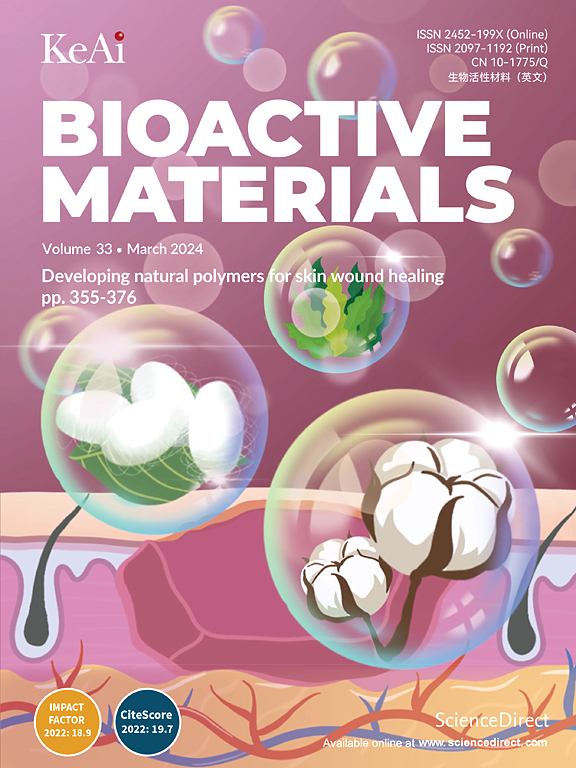A multifunctional hydrogel loaded with magnesium-doped bioactive glass-induced vesicle clusters enhances diabetic wound healing by promoting intracellular delivery of extracellular vesicles
IF 18
1区 医学
Q1 ENGINEERING, BIOMEDICAL
引用次数: 0
Abstract
The treatment of diabetic wounds (DWs) poses a significant medical challenge. Mesenchymal stem cell-derived small extracellular vesicles (sEVs) have demonstrated potential in accelerating healing by delivering growth factors and microRNAs. However, the rapid clearance by the circulatory system limits their concentration and bioavailability within cells. This study employed magnesium-doped bioactive glass (MgBG) to autonomously program sEVs into a vesicle cluster (EPPM), which was subsequently incorporated into a hydrogel to create a comprehensive repair system that enhanced the delivery of both sEVs and MgBG, thereby promoting rapid healing of diabetic wounds. This hydrogel exhibited excellent injectable, self-healing and bioadhesive properties, making it an ideal physical barrier for DWs. In addition, the hydrogels also possessed photoresponsive properties that facilitated their bactericidal activity. The released EPPM significantly increased the intracellular uptake and accumulation of sEVs, with approximately 8.2-fold enhancement in macrophages and 16.7-fold in endothelial cells. The EPPM clusters efficiently induce macrophage M2 polarization, reduce inflammatory responses at the wound site, and recruit cells, thereby promoting angiogenesis and collagen deposition. This integrated repair system provided a new platform for the comprehensive treatment of diabetic wounds.

一种装载了掺镁生物活性玻璃诱导囊泡簇的多功能水凝胶,通过促进细胞外囊泡的细胞内递送来促进糖尿病伤口愈合
糖尿病性伤口的治疗是一项重大的医学挑战。间充质干细胞衍生的小细胞外囊泡(sev)已被证明具有通过递送生长因子和microrna来加速愈合的潜力。然而,循环系统的快速清除限制了它们在细胞内的浓度和生物利用度。本研究采用掺镁生物活性玻璃(MgBG)将sev自主编程成囊泡簇(epppm),随后将其纳入水凝胶中,创建一个全面的修复系统,增强sev和MgBG的递送,从而促进糖尿病伤口的快速愈合。该水凝胶具有良好的可注射性、自愈性和生物粘附性,是DWs的理想物理屏障。此外,水凝胶还具有光响应特性,促进了它们的杀菌活性。释放的epppm显著增加了sev在细胞内的摄取和积累,在巨噬细胞中增加了约8.2倍,在内皮细胞中增加了16.7倍。epppm簇有效诱导巨噬细胞M2极化,减少伤口部位的炎症反应,招募细胞,从而促进血管生成和胶原沉积。该综合修复系统为糖尿病创面的综合治疗提供了新的平台。
本文章由计算机程序翻译,如有差异,请以英文原文为准。
求助全文
约1分钟内获得全文
求助全文
来源期刊

Bioactive Materials
Biochemistry, Genetics and Molecular Biology-Biotechnology
CiteScore
28.00
自引率
6.30%
发文量
436
审稿时长
20 days
期刊介绍:
Bioactive Materials is a peer-reviewed research publication that focuses on advancements in bioactive materials. The journal accepts research papers, reviews, and rapid communications in the field of next-generation biomaterials that interact with cells, tissues, and organs in various living organisms.
The primary goal of Bioactive Materials is to promote the science and engineering of biomaterials that exhibit adaptiveness to the biological environment. These materials are specifically designed to stimulate or direct appropriate cell and tissue responses or regulate interactions with microorganisms.
The journal covers a wide range of bioactive materials, including those that are engineered or designed in terms of their physical form (e.g. particulate, fiber), topology (e.g. porosity, surface roughness), or dimensions (ranging from macro to nano-scales). Contributions are sought from the following categories of bioactive materials:
Bioactive metals and alloys
Bioactive inorganics: ceramics, glasses, and carbon-based materials
Bioactive polymers and gels
Bioactive materials derived from natural sources
Bioactive composites
These materials find applications in human and veterinary medicine, such as implants, tissue engineering scaffolds, cell/drug/gene carriers, as well as imaging and sensing devices.
 求助内容:
求助内容: 应助结果提醒方式:
应助结果提醒方式:


